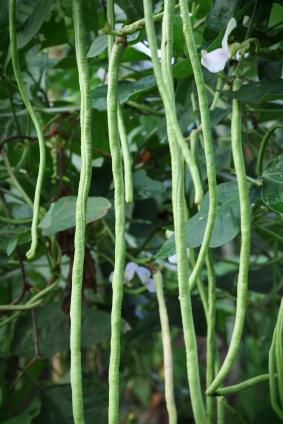
Many people looking for information on how to stake up pole beans forget that pole beans naturally want to climb. If you provide them with support, they will climb. You just need to do your part and provide them with suitable support for their growing habit.
How to Stake Up Pole Beans
Pole beans produce long, tender green beans. Many people prefer the old-fashioned pole bean over bush varieties, claiming they are hardier, more disease resistant, and produce beans longer throughout the growing season. Pole beans do require support. They produce a vine, and need something to cling to as they grow. There are many supports you can make at home or purchase at the garden center for successful cultivation of pole beans. When planning your vegetable garden, take into account pole beans' need for support and space, and you'll be well on your way to successfully growing tasty green beans.
Stakes and Single Supports
Stakes are the traditional support for pole beans. They don't need to be fancy. Purchase stakes or cut long strips of wood at six to eight foot lengths. Hammer them into the ground next to where you intend to plant the beans, then plant seeds at the foot of the stake. The beans will grow and wind up and around. If they need a bit of guidance, some garden twine or a bit of string can be used, but that's essentially how to stake up pole beans. Just provide them with support and up and away they grow, like Jack and the Beanstalk.
Bean Tee Pee
Another method for staking pole beans is to create a tee pee. A tee pee is a support made from three or more stakes hammered into the ground at an angle so that all of the poles tilt inwards and meet near the top, forming a tee pee shape. Create the tee pee first, then plant several bean seeds at the foot of each stake used to create the tee pee. Most tee pees are made from bamboo stakes. They're lightweight, economical, and very sturdy. You can reuse the tee pee from year to year.
Wire or String Trellis
A wire trellis can be made using two stakes and a length of chicken wire. Hammer both stakes into the ground the length of the row you intend to plant with beans. Using a heavy duty outdoor stapler, staple chicken wire to each stake, spreading it as taunt as you can. Plant bean seeds along the bottom of the wire mesh. The beans will grow up and into the trellis. Be sure that the mesh is securely fastened to the stakes, since the vines can be heavy and pull the mesh out of shape.
You can also make a simple trellis from stakes and string. Hammer four stakes into the ground and wind heavy twine around the stakes to form a cat's craddle, moving up at least four to six feet on the stakes. Plant bean seeds under the lines made by the twine.
Tomato Cage
Tomato cages are wire cones or cylinders using heavy gauge, large-hole wires. You can purchase tomato cages ready-made at the garden center. To use them to grow pole beans, simply place the cages firmly in the ground with the spike "feet" planted as deeply as you can into the earth. Then plant the bean seeds around the base of the tomato cage. Since pole beans grow to be six to eight feet in length, they'll outgrow the cages and the tops of the beans will hang off the side. This won't hurt the beans one bit, but they will look kind of straggly. If all you care about is getting plenty of beans in the harvest and you have extra tomato cages, it's an easy solution to staking pole beans.
Recycled Material as Bean Supports
Using recycled materials in the garden offers not only an economical approach but a clever and whimsical one, too. An old ladder, for instance, can be braced against the garage wall, with the ladder feet firmly embedded in the ground. Plant pole beans at the foot and let them vine their way right up the ladder. Old discarded broom and mop handles can be recycled into pole bean supports. Trellises, old pieces of lattice, and bits of wire can all be made into a variety of bean supports. Just keep the following in mind if using recycled materials to grow pole beans:
- Pole beans are vines, so only grow them where you don't mind them climbing up and over…they can be invasive, and heavy when they produce bean pods.
- They grow up to eight feet in length, so make sure your supports are tall enough.
- Always anchor the base of the support, either by hammering sticks into the ground or using some other method.
- Plant beans after placing the support so as not to disrupt the root system.
Nothing says summer like a plate of freshly steamed green beans straight from the garden. After learning how to stake up pole beans, set up the supports and plant seeds soon for a fine harvest.







